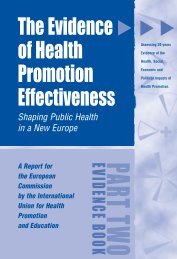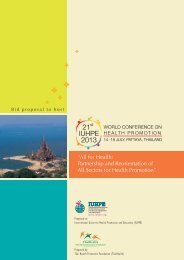Core Document - International Union for Health Promotion and ...
Core Document - International Union for Health Promotion and ...
Core Document - International Union for Health Promotion and ...
Create successful ePaper yourself
Turn your PDF publications into a flip-book with our unique Google optimized e-Paper software.
4 Engaging this group in the development of health promotion programmes has<br />
been key to success. There is evidence of increased condom use, <strong>and</strong> decreases in<br />
drug use. There is less risky sexual behaviour. Socially, there is evidence of<br />
dialogue restarting between the generations, with the young people feeling they<br />
are valued. Some of the programmes in themselves actually provide a source of<br />
income, <strong>and</strong> cost savings to other health services can be identified. Perhaps above<br />
all, the health promotion work in this area has helped put this important social<br />
group back on the agenda.<br />
<strong>Health</strong> Challenges 1: The Lifestyle Killer – Heart Disease<br />
1 Cardiovascular disease (CVD) is the number one killer <strong>and</strong> the major cause of<br />
disability in Europe. Half the deaths in the industrialised world are the result of<br />
CVD. Contrary to widespread mythology, CVD is not something which attacks<br />
only elderly people. Much of the burden concerns the middle aged, women <strong>and</strong><br />
people in lower socio-economic groups. It is a major contributor to inequality<br />
in health.<br />
2 The problems facing decision makers in a Europe which is already<br />
witnessing a reduction (by demographic causes) of its available<br />
working population are first, the early elimination from the work<strong>for</strong>ce of human<br />
talent <strong>and</strong> much needed resource <strong>and</strong> second, the cost of treatment when CVD<br />
disables, but does not kill. The costs to health services are enormous.<br />
3 The major causes of CVD are well known <strong>and</strong> have been well documented:<br />
smoking, poor dietary habits, lack of exercise, high cholesterol. The effects of<br />
these are very heavily influenced by the capacity of people to discriminate <strong>and</strong><br />
make positive health choices. <strong>Health</strong> promotion strategies over the past 20 years<br />
have been shown, without doubt, to make a major difference in tackling those<br />
diseases <strong>and</strong> illnesses which are most significantly affected by the way people<br />
choose to live.<br />
4 One of the most carefully documented interventions has taken place in North<br />
Karelia, Finl<strong>and</strong>, where cardiovascular mortality has been reduced by 73% since<br />
1972, <strong>and</strong> all-cause mortality has been reduced by 50% in the working age<br />
population over the same period.<br />
5 As so often happens, lifestyle changes introduced to deal with<br />
cardiovascular disease threats have a positive benefit in other health<br />
areas too. The North Karelia experience recorded reductions in lung cancer<br />
mortality of 71%, <strong>and</strong> cancer (other causes) mortality by 44%.<br />
6 The example in Finl<strong>and</strong>, while spectacular in its success, is not alone. Other<br />
studies show that programmes aimed at changing lifestyle habits bring very<br />
positive health benefits. In Belgium, a WHO collaborative worksite project <strong>for</strong><br />
CVD prevention resulted in a 25% reduction in CVD mortality. Programmes<br />
aimed at lowering serum cholesterol through healthy diets in schools produced an<br />
average reduction in levels of 15%, with huge positive health implications.<br />
Taking the <strong>Health</strong> <strong>Promotion</strong> Pulse<br />
13






